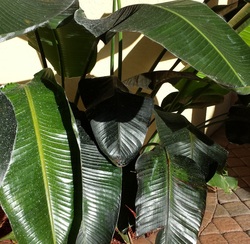Whitefly Treatment
Fig (Ficus) WhiteflyFirst reported in 2007, the Fig Whitefly, also known as the ficus whitefly, has become an ongoing problem for homeowners with ficus trees and hedges. Defoliated ficus hedges and trees are a common sight almost anywhere you go in south Florida.
Early detection and intervention is the key to managing this pest. Ficus whitefly can reproduce rapidly and can quickly take over even the largest tree or hedge. The telltale signs of a Fig whitefly activity are a yellowing of the leaves. Defoliation is the most obvious sign of an infestation, but also means the whitefly have been active for some time. In severe cases, branch dieback can occur. |
Control can be achieved with an application of a systemic insecticide, either drenched into the root zone or applied as a granule. A foliar
application of a contact insecticide is usually necessary to control existing whiteflies and allow time for the systemic treatment to take effect. Treatments usually last about 4-6 months and may require follow up treatments.
application of a contact insecticide is usually necessary to control existing whiteflies and allow time for the systemic treatment to take effect. Treatments usually last about 4-6 months and may require follow up treatments.
FAQ
1. How do I know if I have Ficus Whitefly?
A. The most noticeable signs that you have this species of whitefly a rapid defoliation of the plant. Whiteflies may also be observed flying out of
the hedge if shaken. As the infestation progresses and becomes more severe, a dieback of the branches may occur.
2. Is my tree going to die?
A. In most cases, if caught at an early stage, the tree of hedge will usually produce new leaves. Newly planted and unhealthy trees or hedges
that are in areas of high whitefly populations are most susceptible to sever damage from the whiteflies themselves. However, if the infestation is
severe or the plant is suffering from other problems, branch dieback may occur.
3. What is the best way to treat my plants?
A. Control can be achieved with an application of a systemic insecticide, either drenched into the root zone or applied as a granule. A foliar
application of a contact insecticide is usually necessary to control existing whiteflies and allow time for the systemic treatment to take
effect. Treatments usually last about 4-6 months and may require follow up treatments.
4. Is there anything else I should do to help my trees recover?
A. Proper watering and fertilization will help the trees recover from the stress caused by the feeding of the whiteflies. If the trees
are in bad shape, an application of a slow-release fertilizer is recommended.
B. If damage is severe and branch dieback has occurred, cut out all dead plant material. Monitor the plants for evidence of
new activity on a regular basis.
A. The most noticeable signs that you have this species of whitefly a rapid defoliation of the plant. Whiteflies may also be observed flying out of
the hedge if shaken. As the infestation progresses and becomes more severe, a dieback of the branches may occur.
2. Is my tree going to die?
A. In most cases, if caught at an early stage, the tree of hedge will usually produce new leaves. Newly planted and unhealthy trees or hedges
that are in areas of high whitefly populations are most susceptible to sever damage from the whiteflies themselves. However, if the infestation is
severe or the plant is suffering from other problems, branch dieback may occur.
3. What is the best way to treat my plants?
A. Control can be achieved with an application of a systemic insecticide, either drenched into the root zone or applied as a granule. A foliar
application of a contact insecticide is usually necessary to control existing whiteflies and allow time for the systemic treatment to take
effect. Treatments usually last about 4-6 months and may require follow up treatments.
4. Is there anything else I should do to help my trees recover?
A. Proper watering and fertilization will help the trees recover from the stress caused by the feeding of the whiteflies. If the trees
are in bad shape, an application of a slow-release fertilizer is recommended.
B. If damage is severe and branch dieback has occurred, cut out all dead plant material. Monitor the plants for evidence of
new activity on a regular basis.
Roguse Spiraling Whitefly
|
In late summer of 2011, a species of whitefly was reported to be attacking several palm and plant species in Palm Beach County. The Rugose
Spiraling Whitefly has been spreading rapidly and has a wide range of hosts. Unlike the Ficus Whitefly, the spiraling whitefly is not expected to cause severe defoliation or die-back of the infected plant. In cases of heavy infestation some damage or leaf drop may
occur. They do however, secrete a substance known as honeydew, upon
which, black sooty mold can build up and coat anything in the immediate area with a black, sticky mess.
The Spiral Whitefly has been found on a wide variety of palms and trees including Gumbo Limbo, Oak, Mango, Black Olive, Coconut Palms, Christmas and Areca Palms, etc. Many plant species are also susceptible such as Cocoplum, Copperleaf, Wax Myrtle, Bird of Paradise, etc. More host plants are still being reported. |
Early detection and intervention are the key to managing this pest. The telltale signs of a spiral whitefly infestation are eggs laid in a spiral pattern on the underside of the leaves and an accumulation of a white, waxy substance that covers the eggs. A buildup of black sooty mold coating the
leaves and surrounding area is another sure sign of Spiral Whitefly.
Control can be achieved with an application of a systemic insecticide, either drenched into the root zone or directly injected into the trunk.
A foliar application of a contact insecticide may be needed in cases of severe infestations to control existing whiteflies and allow time for the systemic treatment to take effect.
FAQ
1. How do I know if I have Spiraling Whitefly?
A. The most noticeable signs that you have this species of whitefly is a buildup of a white, waxy material covering the leaves. Whiteflies excrete a
substance called honeydew, a sticky substance, which causes growth of sooty mold. As the infestation progresses, a mixture of honeydew and
sooty mold will fall out of the tree and coat anything in the immediate area, turning it black and sticky.
2. Is my tree going to die?
A. In most cases, Spiral Whitefly will not kill larger, healthy trees. Newly planted and unhealthy trees that are in areas of high whitefly
populations are most susceptible to sever damage from the whiteflies themselves. However, if the infestation is severe and a large amount of
sooty mold is allowed to build up on the leaves, it may interfere with photosynthesis and cause reduced plant growth, early leaf drop and
decrease the trees ability to recover from other environmental stresses like drought.
3. What is the best way to treat my plants?
A. For small trees and shrubs, a systemic insecticide applied directly to the plant or drenched into the soil. Soil applications usually last
longer than foliar treatments but may take longer to work. 1-2 weeks for smaller trees and up to 30+ days for larger trees.
B. For larger trees, we recommend directly injecting a systemic insecticide into the tree. By bypassing the root system, direct injections begin to
work faster and last longer, 6 + months in most cases.
4. How do I get rid of the black, sticky residue coating my plants, patio etc.?
A. After the treatment takes effect and the whiteflies begin to die, the honeydew and sooty mold will begin to dry up and stop falling out of the tree.
Hosing off the foliage may help to wash off some of the sooty mold. Once the whiteflies are under control, trim off any branches that have a
heavy black buildup. Patios, patio furniture, driveways etc. may be cleaned off by scrubbing with soapy water or with a pressure washer.
5. Is there anything else I should do to help my trees recover?
A. Proper watering and fertilization will help the trees recover from the stress caused by the feeding of the whiteflies. If the trees
are in bad shape, an application of a slow-release fertilizer is recommended.
leaves and surrounding area is another sure sign of Spiral Whitefly.
Control can be achieved with an application of a systemic insecticide, either drenched into the root zone or directly injected into the trunk.
A foliar application of a contact insecticide may be needed in cases of severe infestations to control existing whiteflies and allow time for the systemic treatment to take effect.
FAQ
1. How do I know if I have Spiraling Whitefly?
A. The most noticeable signs that you have this species of whitefly is a buildup of a white, waxy material covering the leaves. Whiteflies excrete a
substance called honeydew, a sticky substance, which causes growth of sooty mold. As the infestation progresses, a mixture of honeydew and
sooty mold will fall out of the tree and coat anything in the immediate area, turning it black and sticky.
2. Is my tree going to die?
A. In most cases, Spiral Whitefly will not kill larger, healthy trees. Newly planted and unhealthy trees that are in areas of high whitefly
populations are most susceptible to sever damage from the whiteflies themselves. However, if the infestation is severe and a large amount of
sooty mold is allowed to build up on the leaves, it may interfere with photosynthesis and cause reduced plant growth, early leaf drop and
decrease the trees ability to recover from other environmental stresses like drought.
3. What is the best way to treat my plants?
A. For small trees and shrubs, a systemic insecticide applied directly to the plant or drenched into the soil. Soil applications usually last
longer than foliar treatments but may take longer to work. 1-2 weeks for smaller trees and up to 30+ days for larger trees.
B. For larger trees, we recommend directly injecting a systemic insecticide into the tree. By bypassing the root system, direct injections begin to
work faster and last longer, 6 + months in most cases.
4. How do I get rid of the black, sticky residue coating my plants, patio etc.?
A. After the treatment takes effect and the whiteflies begin to die, the honeydew and sooty mold will begin to dry up and stop falling out of the tree.
Hosing off the foliage may help to wash off some of the sooty mold. Once the whiteflies are under control, trim off any branches that have a
heavy black buildup. Patios, patio furniture, driveways etc. may be cleaned off by scrubbing with soapy water or with a pressure washer.
5. Is there anything else I should do to help my trees recover?
A. Proper watering and fertilization will help the trees recover from the stress caused by the feeding of the whiteflies. If the trees
are in bad shape, an application of a slow-release fertilizer is recommended.





